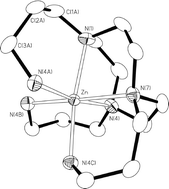Co-ordination chemistry of amino pendant arm derivatives of 1,4,7-triazacyclononane
Abstract
The binding properties of

* Corresponding authors
a Dipartimento di Chimica Inorganica ed analitica, University of Cagliari, Complesso Universitario di Monserrato, S. S. 554 Bivio per Sestu, 09042 Monserrato (CA), Italy
b Dipartimento di Chimica, Università di Firenze, Via della Lastruccia 3, 50019 Sesto Fiorentino, Florence, Italy
c
School of Chemistry, The University of Nottingham, University Park, Nottingham, UK
E-mail:
M.Schroder@nottingham.ac.uk
The binding properties of

 Please wait while we load your content...
Something went wrong. Try again?
Please wait while we load your content...
Something went wrong. Try again?
L. Tei, A. Bencini, A. J. Blake, V. Lippolis, A. Perra, B. Valtancoli, C. Wilson and M. Schröder, Dalton Trans., 2004, 1934 DOI: 10.1039/B404312J
To request permission to reproduce material from this article, please go to the Copyright Clearance Center request page.
If you are an author contributing to an RSC publication, you do not need to request permission provided correct acknowledgement is given.
If you are the author of this article, you do not need to request permission to reproduce figures and diagrams provided correct acknowledgement is given. If you want to reproduce the whole article in a third-party publication (excluding your thesis/dissertation for which permission is not required) please go to the Copyright Clearance Center request page.
Read more about how to correctly acknowledge RSC content.
 Fetching data from CrossRef.
Fetching data from CrossRef.
This may take some time to load.
Loading related content
